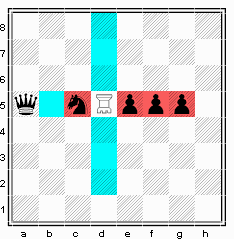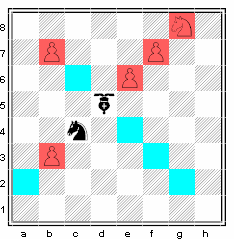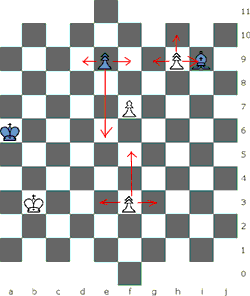Flying Warmachines
Flying Warmachines is a simple transformation of orthodox chess into a bigger 104 square board game with two pairs of new pieces: the Flying WarElephants and the Flying Warmachines, knights with extra stepping abilities: the Ferz Knight and the Wazir Knight, and a new stronger pawn: the Ninja Pawn, 5 of which can be dropped during play.The Flying WarElephant is basically a short-range bishop with leaping capabilities and likewise the Flying Warmachine is a short-range leaping rook.
There are also some modifications to the castling rules (flexible castling), En-passant and initial pawn moves.
While the increased board size and newer pieces changes many parameters, the tactics and strategy of the original game still remain.
Discontinued - Please read this.
Board Setup
 |
Flying Warmachine Chess Main Start position
Coordinates for white. (black mirrors white) Flying WarElephants on a1, j1 Rooks on b1,i1 Knights on c1,h1 Bishops on d1, g1 Queen on e1 King on f1 Flying Warmachines on e0,f0. |
The Pieces
The standard pawn
Moves exactly as in standard chess except:The pawn can move from its original position either 1, 2 or 3 vacant squares forward.
If it previously moved only 1 space originally or captured from original position, it can move forward two spaces towards the center.
En-passant is logically applied to meet these changes.
see rules for more info.
The Ferz-Knight
- It can move one diagonal step in any direction.
- It can leap to any path traced out by one diagonal square followed by one orthogonal square outwards (135 degrees angle).
- It captures on the square it lands. Leaped over pieces are unaffected.
The Wazir-Knight
- It can move one orthogonal step in any direction.
- It can leap to any path traced out by one orthogonal square followed by one diagonally outwards (135 degrees angle).
- It captures on the square it lands. Leaped over pieces are unaffected.
The Flying Warmachine
The Flying Warmachine possesses multiple modes of movement and capture.- It can move along any clear orthogonal path up to 3 squares like a short-range rook.
- It can jump over an orthogonal adjacent piece like a 2 space leaper such as a war machine.
- It can jump over two adjacent pieces landing three orthogonal squares away. It can make this jump only if two pieces (regardless of color) lie between it and the target square. Note that it can NEVER jump 3 squares away if only one piece lies in between.
- It can capture the first enemy piece it bumps into on its 3 square clear orthogonal path.
- It can also capture enemy piece two squares away by jumping an adjacent piece.
- It can capture enemy piece three squares away by jumping two adjacent pieces.
Note there must be 2 pieces in between for the flying Warmachine to jump 3 squares away.
 |
The Flying Warmachine on d5 can move to all the squares in blue or capture all the enemy pieces shown except the queen.
It can capture the knight by moving to c5. It can also jump to b5 without capturing the knight. It cannot however capture the queen since two pieces do not lie in between. It can slide one step to the right and capture the pawn at e5 or jump two spaces and capture the pawn at f5 or jump three spaces capturing pawn at g5. |
The Flying Elephant
The Flying Elephant possesses multiple modes of movement and capture.- It can move along any clear diagonal path up to 3 squares like a short-range Bishop.
- It can jump over one diagonal adjacent piece like an Alfil or Elephant.
- It can jump over two adjacent pieces landing three diagonal squares away. It can make this jump only if two pieces (regardless of color) lie between it and the target square. Note that it can NEVER jump 3 squares away if only one piece lies in between.
- It can capture the first enemy piece it bumps into on a clear diagonal path.
- It can capture enemy piece two squares away by jumping an adjacent piece.
- It can capture enemy piece three squares away by jumping two adjacent pieces.
 |
The Flying Elephant on d5 can move to all the squares in blue or capture all the enemy pieces shown in red squares.
It can capture the pawn by moving to e6. It can jump and capture pawn at f7 or jump and capture knight on g8. It can jump over the black knight and capture the pawn at b3. It can also slide towards b7 and capture the pawn. |
The Ninja Pawn

 The ninja pawn possesses slightly different modes of movement and capture depending on which half of the board it is on.
The ninja pawn possesses slightly different modes of movement and capture depending on which half of the board it is on.
Movement:
The ninja pawn can always move 1 square up or 1 square sideways to an empty square regardless of where it is situated on the board.
From the middle exactly, (rank 5 for white, rank 6 for black), the ninja pawn can move only 1 square forward, but thereafter as soon as it enters enemy territory (the upper half of the board: White rank 6-10, and for black rank 5 - 1), the pawn can go forward either 1 OR 2 empty spaces
Capture:
Like the standard pawn it can capture one square diagonally up, regardless of which half of the board it is on.
When the ninja pawn is on the top half of board (White rank 6 +, Black rank 5-) , it can also capture one square horizontally.
There is no en passant. It cannot capture another pawn or ninja pawn en passant nor can any other pawn capture it this way.
Promotion: The ninja pawn promotes on the last row (rank 10 for white, rank 1 for black), to any piece. Promotion to a piece is mandatory so it would cease to be a pawn in the last row.
Dropping:
The ninja pawn is not present at the start at the game and is dropped by the player into the drop zone, which are the 2nd row squares (row 9 for black, 2 for white). For example, the drop zone for white is a2-j2 and for black a9-j9.
The square must be vacant to drop the pawn. You can drop a pawn to check or to checkmate the opposing king
A maximum of 5 ninja pawns (1 per turn) can be dropped by each side during a game.
After dropping a pawn, the player can optionally move the ninja pawn forward 1 or multiple squares towards the center on the same move.
A capture or a side move is not permitted during the drop, so the player can just drop a pawn, or drop a pawn and move it 1-3 vacant squares towards the center.
 |
In diagram, the black ninja pawn can go from e9-e6 or any other square in between or d9 or f9. The white pawn at f7 cannot capture it en passant Lets say the white ninja pawn went from e3-f3 , it still has the option of shooting forward to the middle (f5) regardless of how many moves it made before. e.g. it can go e2-e3, then e3-f3 . It can now (see diagram) go f3-f5 if unobstructed.The white ninja pawn at h9 can capture the bishop at i9 in addition to being able to go to g9 or to promote by going to h10. |
Rules
-
Castling:
Unlike standard Chess, castling is flexible with the king able to travel 1, 2, 3, or 4 squares towards the rook.
There are 7 possible castling positions, the most extreme wing castling involves the king relocating to the b or i file. The choice of castling positions will depend on whether it is immediately necessary for the king to be tucked away at the wing or for the rook to be centralized.
The usual castling criteria apply: No piece can occupy the spaces travelled by the king and castling rook. Cannot castle out of check. King cannot pass over or land on squares attacked by enemy, but rook can.-
1 space transposition - King Side Castling
White moves King one space from f1-g1 and rook from i1-f1
Black moves King one space from f10-g10 and rook from i10-f10 -
1 space transposition - Queen Side Castling
White moves King one space from f1-e1 and rook from b1-f1
Black moves King one space from f10-e10 and rook from b10-f10 -
2 space transposition - King Side Castling
White moves King two spaces from f1-h1 and rook from i1-g1
Black moves King two spaces from f10-h10 and rook from i10-g10 -
2 space transposition - Queen Side Castling
White moves King two spaces from f1-d1 and rook from b1-e1
Black moves King two spaces from f10-d10 and rook from b10-e10 -
3 space transposition - King Side Castling
White moves King three spaces from f1-i1 and rook from i1-h1
Black moves King three spaces from f10-i10 and rook from i10-h10 -
3 space transposition - Queen Side Castling
White moves King three spaces from f1-c1 and rook from b1-d1
Black moves King three spaces from f10-c10 and rook from b10-d10 -
4 space transposition - Queen Side Castling
White moves King four spaces from f1-b1 and rook from b1-c1
Black moves King four spaces from f10-b10 and rook from b10-c10
Any other piece can occupy j1, j10, a10 or a1 during castling. -
1 space transposition - King Side Castling
-
Pawn Movement ():
The pawn can move from its original position either 1, 2 or 3 vacant squares forward.
A pawn, which initially moved forward 1 square or captured from its starting position, can subsequently at any time move forward 1 or 2 vacant squares. Once it reaches the center of the board (rank 5 for white, rank 6 for black), it can move forward only one square at a time.
Some examples: the white pawn at f2 can start f2-f5 or it can move f2-f4 then f4-f5, or f2-f3 followed by f3-f5, or move f2-g3 to capture enemy piece at g3 followed by g3-g5 next time it moves. - En Passant: If a Pawn moves two or three squares initially and passes an enemy Pawn on the
4th or 5th rank, it may be captured en passant by the enemy pawn.
E.g. White pawn on a2 black pawn on b4. White pawn moves a2 - a4 (or a5), black pawn on b4 can capture it as if it had moved to a3.
Similarly, black pawn on b5 and white pawn moves a2 - a5, then black pawn can capture the white pawn as if it moved to a4. Note in this case the white pawn can still avoid the black pawn by moving to a3 instead.
If a pawn slides forward 2 squares on its second move, it can also be captured en passant by an opposing pawn on the fifth rank. E.g. white pawn on a3 and black pawn on b5. White plays a3-a5, black pawn on b5 can capture the pawn en passant by moving to a4.
Capturing en passant is optional unless it is the only legal move available. The capture must be made on the next move. - Pawn promotion: Pawns or Ninja Pawns can now promote to: Queen, Bishop, Ferz Knight, Wazir Knight, Rook, Flying Warmachine or WarElephant. on the 10th rank only.
- Ninja Pawns are unaffected by En Passant and cannot capture En Passant.
Play the Game!
The author has discontinued this game. Please contact the author if you would like to see future development of this game.
As of 9/9/2009 I have lost interest in chess variants though I still have interest for 8x8 chess varieties like Fischer Random, Displacement Chess, pre-Chess or using King to Bunker Leap rules on Shuffle Chess.
It seems to me that not enough people appreciate larger board chess, and perhaps for good reason. Who needs it?
Unfortunately, the chess variant community is going the wrong direction, constantly bickering, and at every available opportunity denigrating the chess that everyone loves.
A truly sad bunch of low rated chess players, they cover up their own flaws in chess skill with their constant harping on the supposed "flaws" in the chess rules.
This means that large board chess will only be explored by these holier than thou activists interested in forcing people to stop playing regular chess. Mostly, they prefer some inferior variant with silly rules meant to "fix" chess.
That being said, I have not fully abandoned chess variants; I am merely leaving it for those enlightened souls who would like to explore different types of chess in their leisure.
Of course, it may very well be just a few in the chess variant community (as little as 3!) who hate chess, but unfortunately they are the most vocal.
I have also decided my time is better spend playing or studying regular chess than worrying about new chess variants that no one cares about.
|
If you would like to email the chess variant inventor directly: inventor@chess.computerwebservices.net
|

